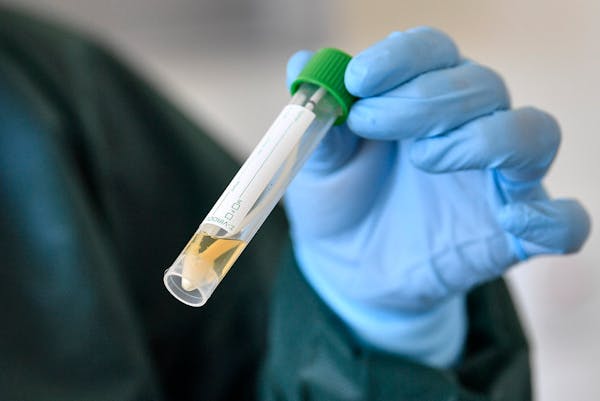The Mayo Clinic's first batch of coronavirus tests found no sign of the virus in 90 samples, a clinic official said Friday, suggesting that the virus in Minnesota is likely not widespread at this point.
Mayo Clinic Laboratories announced this week that it has begun rolling out a new coronavirus test as concerns have been building across the country about whether there's a lack of testing capabilities.
In its first 36 hours of testing, the lab at Mayo received about 200 samples, said Matthew Binnicker, director of the clinical virology lab at Mayo Clinic in Rochester. Mayo said it can perform up to 300 tests per day and could be adding technology in the coming weeks to greatly expand the volume.
"I think we want to expand testing in terms of our ability to do testing, but we also want to focus on testing patients who have symptoms and meet the clinical criteria," Binnicker said. "We really need to focus on utilizing the testing in a thoughtful way — when a physician has ordered the test and thinks, based on the patient's clinical criteria, that the test is needed."
Of the testing results thus far, Binnicker said: "That's really good news. ... The virus is here in Minnesota, but the test results suggest it is likely not widespread at this point."
The Minnesota Department of Health started testing for the virus that causes COVID-19 on Jan. 20. As of Friday, the department was reporting that 14 patients had tested positive for the virus out of about 555 patients tested.
In mid-February, Mayo fast-tracked development of a coronavirus test as the outbreak started to overwhelm the health care system in China and spread around the globe. Other commercial labs also have been launching tests this month, with the director of the federal Centers for Disease Control and Prevention (CDC) telling lawmakers Thursday that millions of tests are coming online.
The supply is arriving after some public health experts have suggested the government should have enlisted the help of labs earlier in the outbreak. There are signs the nation needs "a better system for helping states that lack capacity be able to share their samples with those labs that have spare capacity," Dr. Scott Gottlieb, the former commissioner of the Food and Drug Administration in the Trump administration, said via Twitter on Friday.
Plus, as more tests are becoming available, labs are facing shortages in "extraction kits," which are chemicals used to pull RNA from specimens for testing.
"The test isn't the whole answer," said Dr. Robert Redfield, the CDC director, in testimony Thursday before an oversight committee in the U.S. House of Representatives. "You need people to do the tests, laboratory equipment to do the tests, you need some of the re-agents that actually now are in short supply in order to prepare the test."
Binnicker, the lab official at Mayo, said the shortage of extraction kits is a problem but not yet a limiting factor for tests being conducted at Mayo. For now, the clinic is testing samples coming from patients at Mayo's hospital in downtown Rochester as well as a drive-through collection site in the city.
It's not a drive-through that's open to anyone in the public, Binnicker said; it is reserved for patients who have phoned ahead and talked with doctors and nurses about whether their symptoms warrant testing. Health care professionals need to be careful with the testing supply, he said, because it's not clear what volume of tests will be needed in the future. Binnicker said it's likely that other clinical labs in the state will need to develop testing capabilities in the coming weeks.
During the House hearing on Thursday, Rep. Debbie Wasserman Schultz, D-Fla., read a statement from the National Nurses United union saying it was aware of "multiple circumstances" in which health care workers exposed to COVID-19 did not receive coronavirus tests despite requests for testing.
"Will you admit that there is a serious problem in this country with individuals, even health care workers, obtaining access to testing for coronavirus?" Wasserman Schultz asked Redfield.
Dr. Anthony Fauci, director of the National Institute of Allergy and Infectious Diseases, responded during the hearing that the U.S. system for testing has been built on a model in which individual patients with symptoms seek care from doctors, who then order tests. What's needed now — and isn't fully available, Fauci said — is a system where people have easier access to testing.
"It is a failing — let's admit it," Fauci said.
In February, federal officials had to resolve a technical problem that hindered wide testing. During the Thursday hearing, Rep. John Sarbanes, D-Md., asked if testing troubles mean the country missed a chance at containing the virus spread and must now go straight to mitigation measures designed to slow the spread.
Fauci replied that "you can't draw a direct line" between the two, adding that public health officials can still do some containment even as they stress mitigation measures.
"Right now, all of us — regardless of what testing is going on — need to be doing the kind of distancing, avoiding crowds, tele-working where possible," Fauci said. "This is not business as usual. If you live in a state or a region where there are just a few or no cases, it doesn't matter. You really need to."
Christopher Snowbeck • 612-673-4744
Twitter: @chrissnowbeck
Tennessee Volkswagen workers vote on union membership in test of UAW's plan to expand its ranks
Bitcoin's latest 'halving' has arrived. Here's what you need to know
BNSF Railway says it didn't know about asbestos that's killed hundreds in Montana town
Here's how Phish is using the Sphere's technology to give fans something completely different

